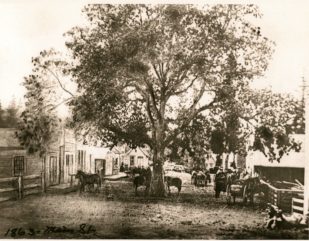Gone but not forgotten – tree memorials
Posted on: November 28th, 2016 in News & Press, Newsletter |
Notable trees that once graced Oregon
There are notable trees aplenty in Oregon, and you may have visited some of them on weekend forays across the state. However, trees have finite lifetimes. They are vulnerable to disease, rot, weather or humankind incidents. While not all of the trees represented in the“tree memorial” are Oregon Heritage Trees, during their lifespans many were beloved in their communities and by tree aficionados.
We will be adding more “gone but not forgotten” trees below, as the Oregon Heritage Tree Committee unearths more contenders. If you would like to tell us about a tree (or trees) that had a vital connection to Oregon history, please contact us.
Silverton Oak Tree
Homer Davenport lamented the passing of the tree in his book “Country Boy.” The stump of the oak tree was unearthed during street excavation work in 1966. The stump was preserved and now rests beneath a special gazebo in a park next to the Silverton Country Historical Society (428 S. Water St, Silverton), not far from where it once grew. (*Image courtesy of Silverton Country Historical Society) |
Sheepshooter Tree
|
“Klondike Kate’s” petrified stumps
After Kate relocated from her homestead to Bend, she arranged for the petrified stumps to be hauled into Bend. At the time, the Bend Bulletin pegged the stumps to be in excess of 20,000 years old. The stumps were presented to the firemen of the city and were installed near their downtown station by a memorial fountain. When the fire station was later relocated, the stumps were gifted to the City of Bend who installed them in Drake Park. They remain in Drake Park to this day. (*Image courtesy Nate Pedersen) Learn more about Klondike Kate Rockwell. |
Mammoth Sugar Pine
The Mammoth Sugar Pine was the giant among giants, standing at 224” tall, with a girth of 7’11.” By the time the tree succumbed to bark beetles in 1966, it was over 300 years old. The other mature sugar pines met a similar fate in the original stand, and the interpretive center eventually fell into disuse. Scattered large sugar pines can still be found today in sections of the Rogue River National Forest. (*Image of vintage postcard—from the collection of Nate Pedersen) |
Abernethy Elm
An Oregon White Oak (Quercus garryana) has been planted nearby to commemorate both the Abernethy Elm and the opening of the Willamette Terrace and Jon Storm Park in 2010. (*Image courtesy of the Clackamas County Historical Society) |
Judge Shaw Christmas Tree
The lighting of the Judge Shaw Christmas tree became an annual event for the Salem community until 1951. By that time, the tree had reached a height of 72 feet and was becoming difficult to decorate. Expansion plans for the county courthouse led to the tree being cut down in 1952. (*Image courtesy of the Willamette Heritage Center.) |
 Payments
Payments




